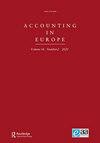Auditors’ Carbon Risk Consideration under the EU Emission Trading System
IF 4.3
Q1 BUSINESS, FINANCE
引用次数: 0
Abstract
ABSTRACTThis paper addresses the effects of clients’ carbon risk on audit pricing. Using data from 438 EU companies for the period 2013–2019, we find a positive relationship between carbon risk (measured by the level of carbon emissions) and audit fees. Furthermore, we find that participation in the European Union’s Emission Trading System, a limited market and regulation scheme to mitigate special industries’ Greenhouse Gas emissions, strengthens the positive relationship between carbon risk and audit fees. Insights from additional tests indicate that auditors price carbon risk particularly for large clients that are under greater public scrutiny and that the increase in fees rather stems from a risk premium charged by the auditor than higher audit effort. With interest in climate change developing rapidly across society, practice and research combined with the increasing importance of reducing carbon risk, our findings are timely and should thus appeal to a wide variety of recipients.Keywords: audit feesaudit riskcarbon riskGHG emissionEU emission trading system AcknowledgementsWe thank Max Göttsche, Francesco Mazzi, Frank Schiemann and seminar participants at the 17th Workshop on European Financial Reporting (EUFIN), University of Bamberg and University of Ingolstadt for valuable comments and suggestions. All errors remain our own.Disclosure StatementNo potential conflict of interest was reported by the authors.Notes1 In the context of sustainability reporting, Hummel and Szekely (Citation2022) have recently shown that not only financial stakeholders (e.g., analysts, investors, lenders) but also non-financial stakeholders (e.g., media, employees, customers) are important in building pressure on firms’ sustainability behavior.2 For further information and reference see: https://www.reuters.com/article/us-climate%20change-accounts-exclusive/exclusive-big-four-auditors-face-investor-calls-fortougher-climate-scrutiny-idUSKBN1Y21XK3 See for instance the results of the Yale Climate Opinion Survey, which are publicly available and discussed in Marlon et al. (Citation2022).4 However, it is important to note that regulation alone is not sufficient in increasing the awareness for climate change risks but that informal institutions like cultural-cognitive factors are also important (Panfilo & Krasodomska, Citation2022).5 Some studies more broadly define carbon risk a set of environmental risks which ‘describe any corporate risk related to climate change or the use of fossil fuels’ (Hoffmann & Busch, Citation2008, p. 514). According to this definition, carbon risk relates to firms’ reliance on fossil fuels and corresponding socio-political factors such as government-related measures and changes in consumer preferences, but also the direct physical effects of climate change (Jung et al., Citation2018). In this paper, we follow the definition by the FSB and understand carbon risk mainly as the indirect transitional risks from climate change for carbon-intensive firms.6 Simunic (Citation1980) shows in his seminal paper that audit fees are the total expected costs of performing an audit, including the auditing hours expended and allowances made for future losses, for instance due to litigation risks.7 Meanwhile, it is one of the main mechanisms to attain the goals of the European Commission becoming climate neutral by 2050 (European Commission, Citation2020b).8 It includes installations, which are heavy energy using e.g. power and heat generation, oil refineries, steel works and production of iron, aluminum, metals, cement, lime, glass, ceramics, pulp, paper, cardboard, acids and bulk organic chemicals and civil aviation (European Commission, Citation2016).9 In 2013, the cap of stationary installations is 2,084,301,856 allowances and in the aviation sector it is 210,349,264 allowances (European Commission, Citation2020a).10 For further information on the impacts and consequences of free allocation of allowances, we refer to Ellerman et al. (Citation2011).11 For further information see European Commission (Citation2020c).12 Information is provided by the European Union Transaction Log (EUTL).13 Further adjustments focusing on the fourth phase include adjustments due to the commitment of the Paris Agreement signed in 2015, i.e. the reduction of emissions of about 40% compared to the 2005 level (European Commission, Citationn.d.b).14 The yearly reduction of the cap affects only EAUs (allowances for stationary installations) in phase 3 and from 2021 onwards stationary and aviation allowances (European Commission, Citation2020c).15 EU ETS participants are identified with data from the EUTL.16 All continuous variables in our regression models are winsorised at the 1% level.17 At the end of 2019, the United Kingdom was a member of the EU. For further information, see https://ec.europa.eu/info/strategy/relations-non-eu-countries/relations-united-kingdom/eu-uk-withdrawal-agreement_en.18 0.090 = 2.917 * 0.031, in which 2.917 presents the standard deviation of scope1_ln and 0.031 is the estimated coefficient of scope1_ln.19 Additional tests (untabulated) show that the total GHG emissions, which are calculated as the sum of Scope 1 and Scope 2 GHG emissions, are also positively related to audit fees (p-value <.05).20 Further tests (untabulated) show that results are unchanged if we calculate the total GHG emission output as the sum of Scope 1 and Scope 2 GHG emissions.21 We conduct the additional tests and sensitivity analyses only for our Equations 1 (direct effect of carbon risk on audit fees) and 3 (interaction effect), for which we reported significant results in our main tests.22 In this model, we use l_audfee as a control variable.23 Of the remaining industries, only the mining industry has a higher level of carbon emissions compared to the manufacturing industry.24 Additional tests (untabulated) indicate that the findings are more prominent for common-law countries (Great Britain and Ireland). The categorization is based on the classification of La Porta et al. (Citation1998).25 We again attribute this to the significantly lower number of observations for this test, which naturally reduces t-values, particularly bearing in mind that the interaction term indirect_ln*ets_part was already only marginally significant at the 10% level for the full sample.26 Examples are the implementation of a market stability reserve and shortages of overall and free allowance certificates see Section 2.3.欧盟排放交易体系下审计师的碳风险考量
摘要本文研究了客户碳风险对审计定价的影响。利用2013-2019年期间438家欧盟公司的数据,我们发现碳风险(以碳排放水平衡量)与审计费用之间存在正相关关系。此外,我们发现参与欧盟排放交易体系(一个有限的市场和监管计划,以减少特殊行业的温室气体排放)加强了碳风险与审计费用之间的正相关关系。来自额外测试的见解表明,审计师对碳风险进行定价,特别是对那些受到更大公众监督的大客户,费用的增加更多地来自审计师收取的风险溢价,而不是更高的审计工作。随着整个社会对气候变化的兴趣迅速发展,实践和研究结合减少碳风险的重要性日益增加,我们的发现是及时的,因此应该吸引各种各样的接受者。我们感谢Max Göttsche、Francesco Mazzi、Frank Schiemann以及第17届欧洲财务报告研讨会(EUFIN)的与会者、班贝格大学和因戈尔施塔特大学提出的宝贵意见和建议。所有的错误都是我们自己的。披露声明作者未报告潜在利益冲突。注1在可持续发展报告的背景下,Hummel和Szekely (Citation2022)最近表明,不仅金融利益相关者(如分析师、投资者、贷款人),而且非金融利益相关者(如媒体、员工、客户)在对公司可持续发展行为施加压力方面也很重要欲了解更多信息和参考资料,请参阅:https://www.reuters.com/article/us-climate%20change-accounts-exclusive/exclusive-big-four-auditors-face-investor-calls-fortougher-climate-scrutiny-idUSKBN1Y21XK3例如,参见耶鲁气候民意调查的结果,这些结果是公开的,并在Marlon等人(Citation2022)中讨论过然而,重要的是要注意,仅靠监管不足以提高对气候变化风险的认识,文化认知因素等非正式制度也很重要(Panfilo & Krasodomska, Citation2022)一些研究更广泛地将碳风险定义为一系列环境风险,“描述与气候变化或化石燃料使用相关的任何企业风险”(Hoffmann & Busch, Citation2008,第514页)。根据这一定义,碳风险与企业对化石燃料的依赖以及相应的社会政治因素(如政府相关措施和消费者偏好的变化)有关,也与气候变化的直接物理效应有关(Jung et al., Citation2018)。在本文中,我们遵循FSB的定义,将碳风险主要理解为气候变化对碳密集型企业的间接过渡风险Simunic (Citation1980)在他的开创性论文中指出,审计费用是执行审计的总预期成本,包括所花费的审计时间和对未来损失(如诉讼风险)的准备同时,它也是实现欧盟委员会到2050年实现气候中和目标的主要机制之一(欧盟委员会,Citation2020b)它包括装置,这是使用重能源,如发电和供热,炼油厂,钢铁厂和生产铁,铝,金属,水泥,石灰,玻璃,陶瓷,纸浆,纸,纸板,酸和散装有机化学品和民用航空(欧洲委员会,Citation2016)2013年,固定设施的配额上限为2,084301,856个,航空部门的配额上限为210,349,264个(欧洲委员会,Citation2020a)关于自由分配津贴的影响和后果的进一步信息,我们参考了Ellerman等人(Citation2011)更多信息见欧洲委员会(Citation2020c).12信息由欧盟事务日志(EUTL)提供针对第四阶段的进一步调整包括根据2015年签署的《巴黎协定》的承诺进行的调整,即与2005年的水平相比减少约40%的排放量(欧盟委员会,Citationn.d.b)每年减少限额只影响第三阶段的固定设施津贴,并从2021年起影响固定和航空津贴(欧洲委员会,Citation2020c)EU ETS参与者的数据来自EUTL.16我们的回归模型中的所有连续变量都在1%的水平上进行了winsorised2019年底,英国成为欧盟成员国。欲了解更多信息,请参见https://ec.europa.eu/info/strategy/relations-non-eu-countries/relations-united-kingdom/eu-uk-withdrawal-agreement_en.18 0.090 = 2.917 * 0.031,其中2。
本文章由计算机程序翻译,如有差异,请以英文原文为准。
求助全文
约1分钟内获得全文
求助全文

 求助内容:
求助内容: 应助结果提醒方式:
应助结果提醒方式:


